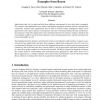Free Online Productivity Tools
i2Speak
i2Symbol
i2OCR
iTex2Img
iWeb2Print
iWeb2Shot
i2Type
iPdf2Split
iPdf2Merge
i2Bopomofo
i2Arabic
i2Style
i2Image
i2PDF
iLatex2Rtf
Sci2ools
103
click to vote
DEBU
1998
1998
The Case for Non-transparent Replication: Examples from Bayou
Applications that rely on replicated data have different requirements for how their data is managed. For example, some applications may require that updates propagate amongst replicas with tight time constraints, whereas other applications may be able to tolerate longer propagation delays. Some applications only require replicas to interoperate with a few centralized replicas for data synchronization purposes, while other applications need communication between arbitrary replicas. Similarly, the type of update conflicts caused by data replication varies amongst applications, and the mechanisms to resolve them differ as well. The challenge faced by designers of replicated systems is providing the right interface to support cooperation between applications and their data managers. Application programmers do not want to be overburdened by having to deal with issues like propagating updates to replicas and ensuring eventual consistency, but at the same time they want the ability to set u...
Related Content
| Added | 22 Dec 2010 |
| Updated | 22 Dec 2010 |
| Type | Journal |
| Year | 1998 |
| Where | DEBU |
| Authors | Douglas B. Terry, Karin Petersen, Mike Spreitzer, Marvin Theimer |
Comments (0)

